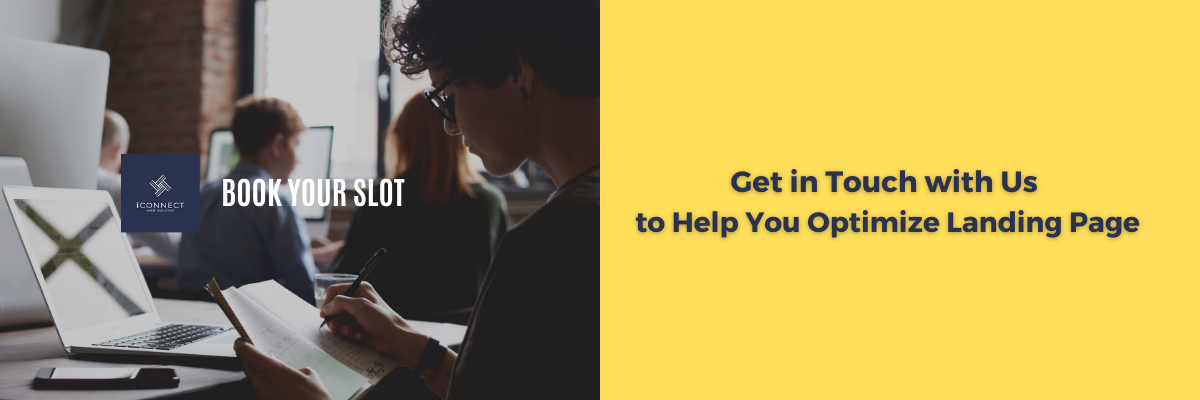

Digital marketing is a diverse and multifaceted field where various factors are simultaneously at play. One such factor is the landing page. Many times, people ignore the importance of a landing page and how it can lead to conversion.


Image Credits:Finances Online
Imagine a visitor ‘lands’ on your page and leaves without taking any action. This could happen due to several reasons like slow load speed, poor navigation, cluttered design, etc. Did you know that a one-second delay in page loading can reduce conversions by 7% (Source: Tech Jury)? Thus, it is crucial to optimize a landing page to avoid such issues.
What Is a Landing Page?
A landing page is the web page where the visitors land on your website. It is specifically designed and created for marketing and advertising purposes and plays a significant role in digital marketing. It is also known as lead capture page, static page, destination page, single property page, or destination page.


Image Credits: Aqusag Technologies
In simple words, the landing page is a single web page that will appear when a visitor clicks on a search engine optimized search result link or ad of your website.
Why You Should Optimize the Landing Page
You should re-evaluate your landing page to assess how customers respond to it – the first page of your website. The landing page experience is a significant factor of overall website experience and is the first impression your visitors get. For example, the easier it is for customers to navigate the page for the shopping cart, the more likely they will purchase.
Moreover, the landing page also affects quality score ad rank position, and overall user experience. Long landing pages can generate 220% more leads. So, if your landing page is not optimized, users will leave your website without making a purchase – decreasing SE ranking, conversion rates, and sales.


Image Credits:Qorva Tech
Best Practices for Optimizing a Landing Page for Google Ads
1. Improve Page Speed
A page with a slow loading speed has a higher bounce rate, reduced conversion rates, and low average on-page time. According to HubSpot case studies, decreasing page load time increases conversions from 3-17%.
So, you have to make sure that your landing page loads instantly because the sooner it does, the more likely e visitors well state to view and convert.
2. Define USP
USP stands for Unique Selling Proposition. Quickly define your USP by aligning the message in your ad and on your landing page. You have to let your visitors know why your product is the perfect solution to their problem. A powerful USP defines what you are offering and why it is the best choice for visitors on your landing page.
Remember: USP and CTA are not the same things. USP is the unique selling point, whereas the CTA attracts visitors to your USP and encourages them to take action.
3. Use CTAs
CTA or call to action is a term or phrase used to induce an immediate and prompt response from your visitors and viewers. They grab the attention of the audience and motivate them to perform a specific action to encourage sales. Landing pages with personalized CTAs have higher conversion rates of 202%.
4. Go Mobile Friendly
86% of the top-ranking landing pages are mobile-friendly (Source: Nifty Marketing). If your website landing page is not mobile-friendly, mobile customers will quickly leave the web page (because they will find it hard to navigate) – thus, having a poor landing page experience. By creating mobile-friendly landing pages, you can deliver a positive experience for mobile users.
5. Make Navigation Easy
A landing page is all about clear communication with the visitor. Organize and design your landing page so that it is easy to navigate and creates a smooth user experience for visitors. An important element to improve navigation is adding visual hierarchy to different page elements. Establishing a visual hierarchy makes the communication between the post-click landing page and the user smooth and seamless. You can make your landing page easier to navigate through:
- F Page Pattern
It allows the visitors to navigate and read the page horizontally. The visitors have to scroll down to access new content. Arrange the visual elements systematically to ensure that the visitors view and absorb the content effectively.
- Z pattern
The Z-pattern layout is ideal for pages with low content. Its design pattern is left to right and zigzagging from top to bottom.
- White Space
White space or negative space, is the extra spaced-out area on a page to highlight or draw attention to a certain element. This reduces clutter on the page and allows visitors to focus on important elements like headings, CTAs, USPs, etc.
6. Clean and Concise Design
Make sure the layout and design of landing page is clean, simple, and concise. It should not be distracting and should have a professional lock that indicates your business is reliable and legitimate. You can add images, reviews, and attractive color schemes to create an impressive landing page.
7. Add Customer Reviews
Adding customer testimonials and reviews help build trust. Positive feedback from your client will create a positive image of your brand and motivate prospects to invest in your product/service. Just a single review can increase your conversion rate by 10%. So, take surveys, reviews, and feedback from clients and share them on the landing page.
Conclusion
The landing page is the user’s first interaction with your brand and business. To leave a long-lasting impression on the visitors, optimize your landing pages for google ads. Implement the practices mentioned in this article to improve landing page ranking, increase conversions and boost sales!


